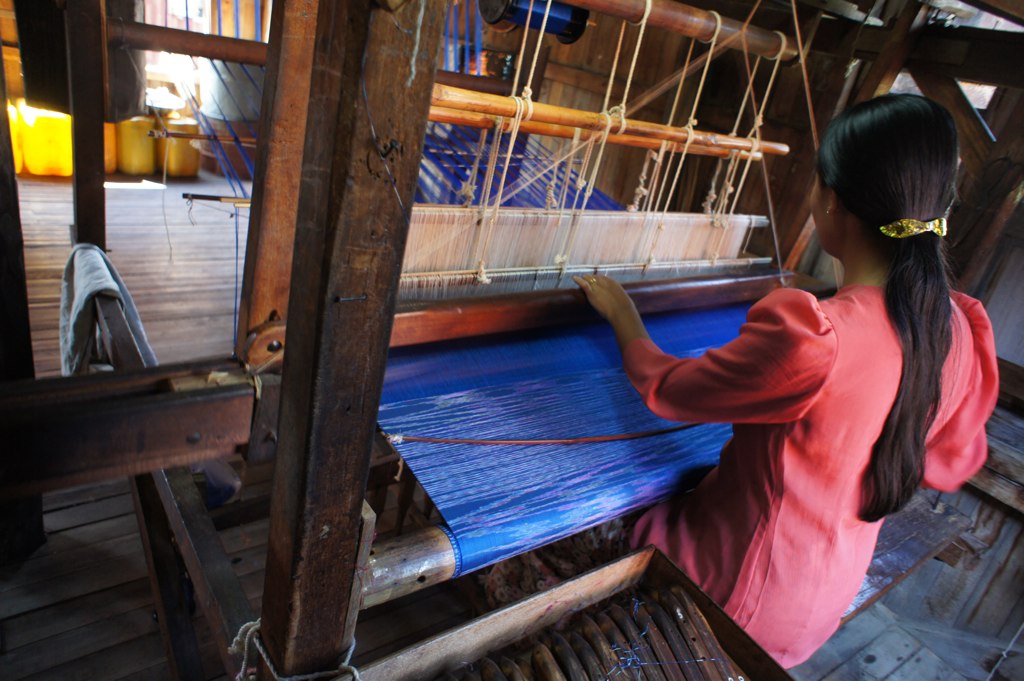The Silk Story

The legend of the Chinese empress who discovered silk when a cocoon accidentally fell into her tea, is an enduring one. One day, the empress, so the story goes, was sipping tea under a mulberry tree when a cocoon fell into her cup and began to unravel. The source of the shimmering threads was traced to the Bombyx mori silkworm and thus began the saga of silk, more than 2500 years ago. It was thought that for nearly 3 millennia, the Chinese had a global monopoly of silk production. However, recent excavations have unearthed wild silk threads from two Indus River sites, Harappa and Chanhudaro, dating to 2450–2000 BCE, roughly contemporaneous with the earliest Chinese evidence for silk. “It was a complete surprise,” say researchers.
The Harappa samples are from the species of Antheraea moths indigenous to South Asia, while Chinese silk comes from the domesticated Bombyx mori. The typical Chinese species are killed before the pupae emerge, allowing the whole cocoon to be unraveled as one continuous thread. This allows for a much finer cloth to be woven from the silk. The Indian worms, on the other hand, produce a tougher and rougher silk.
India produces four kinds of silk: mulberry, tussar, muga and eri. Since the muga, tussar, and eri silkworms, found mostly in the eastern states of India, are not fully tamed, the silks they produce are called vanya - Sanskrit for untamed, wild, or forest-based - silks. They have baffling thermal properties, keeping warm in winter and cool in summer.
Types of Silk
Muga
Exclusive to India and the pride of the eastern state of Assam, the shimmering golden color, distinct look, and smooth feel of Muga is an instant inspiration to designers all over the world. Muga commands the highest premium amongst all silks. The silk often outlives its owner and was previously reserved for the use of royalty. The Muga worms feed on the fragrant Som and Soalu leaves.
Eri
The Eri silkworms feed on Castor and Kesseru leaves. It is the only completely domesticated silkworm, besides the Bombyx mori, which feeds on mulberry leaves. The cocoons are left alone for seven to 10 days. Once the worms mature, they are allowed to pierce the cocoons and fly away as moths. Each cocoon is checked individually to ensure that the moth has escaped before the silk thread is spun. The silk, also called “non-violent silk”, is extremely durable and cannot be easily reeled off the cocoon but can be spun into coarse to very fine yarns. It can also be combined with cotton, wool, jute, and mulberry silk. Eri silk gets a better sheen with every wash. Its high warmth retention makes it comfortable in cooler climes.
Tussar
This is a highly textured silk that comes in a wide range of natural colors, from off-white to beige and gold brown. It has a dull, uneven sheen and can also be dyed and easily blended with cotton, wool, linen or other silks. Tussar silkworms feed mainly on Asan and Arjuna leaves. India is one of the largest producers of Tussar silk in the world. Another variety of Tussar is the Oak Tussar, which is a finer version of Tussar.
Did you know?
-
The Arjuna tree, home of the Tussar worms and named after the well-loved hero of the Indian epic, the Mahabharata, grows to about 20 to 25 meters tall; it usually has a buttressed trunk, and forms a wide canopy at the crown, from which branches drop downwards. It has oblong, conical leaves which are green on the top and brown below. This tree is revered by Ayurveda (Indian traditional medicine) practitioners as a sacred tree and the codified use of its leaves to treat heart disease goes as far back as the 7th century. However, it was known to Indians thousands of years ago to treat wounds, hemorrhages, and ulcers.
-
Silk is nothing but the silkworm’s saliva!
-
Silk cocoons are natural skincare products as they are rich in proteins, amino acids, and even collagen.
-
Strong as steel in tensile strength, silk is the strongest natural fiber known to man.
-
A silk rope is stronger than an equally thick metal wire!
-
It can be stretched between 30 to 40 percent of its length before breaking.
-
Its sheer strength makes it ideal for fiber optic cables and biomedical devices.
-
It has even been used to make ligaments and to dress wounds.
-
Half a kilogram of caterpillars eats up to 12,000 kg of mulberry tree leaves in its lifetime.
-
A silkworm grows to 25 times its size over the first four weeks.
-
5,500 silkworms are required to produce 1 kg of raw silk.
India’s “Freedom” Fabric - Khadi
Khadi is a hand-spun and woven natural fiber cloth promoted by Mahatma Gandhi during India’s independence struggle as a symbol of swadeshi, or self-sufficiency, and freedom from British manufactured goods. The first piece of the hand-woven cloth was manufactured in the Sabarmati Ashram during 1917–18. The cloth is made from cotton, but it may also include silk or wool, which are all spun into yarn on a charkha or spinning wheel. It is a versatile fabric that remains cool in summer and warm in winter.
Quotes on Khadi
“I see God in every thread that I draw on the spinning wheel”
“The sacred quality of khadi is that it is a symbol of freedom”
“…charkha or [the] act of spinning is the symbol of non-violence. Ponder; it will be self-evident.”
“The spinning wheel represents to me the hope of the masses.”
“Charkha is the symbol of the nation’s prosperity and therefore freedom.”
“If we have the khadi spirit in us, then we should surround ourselves with simplicity in every walk of life.”
“The 'khadi spirit' means illimitable patience. It means fellow-feeling with every human being on earth.”
